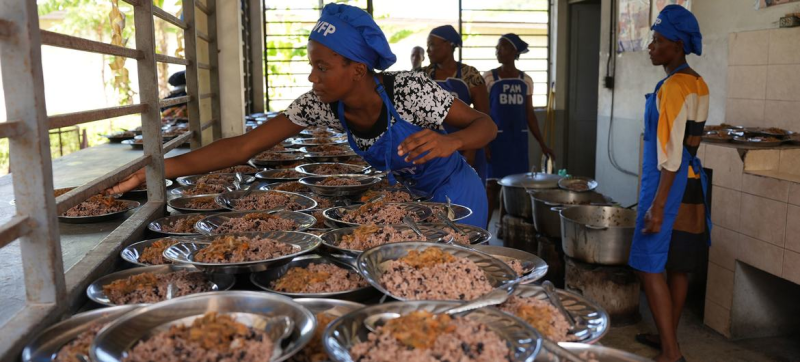- Earthquakes & repeated aftershocks in Dhaka raises concerns |
- Khaleda admitted to Evercare Hospital for health check-up |
- Dhaka records unhealthy air quality on Sunday morning |
- Govt letter to EC to hold election, referendum on same day |
- COP30 boosts funding for at-risk nations but avoids firm fossil fuel terms |
WFP: 80 Million More Children Getting School Meals

Cooks serve school meals to students in Haiti.
School meals are a crucial way out of poverty and into “a new world of learning and opportunity,” according to World Food Programme (WFP) Executive Director Cindy McCain.
The number of children receiving school meals through government-led programmes has increased by 20 per cent since 2020, according to the latest edition of WFP’s flagship biennial report The State of School Feeding Worldwide.
Nearly 80 million more children are now able to enjoy nutritious meals at school, bringing the global total to approximately 466 million.
Beyond health and nutrition, national programmes can also benefit employment, agriculture and other sectors.
“School meals are so much more than just a plate of nutritious food – important as that is. For the vulnerable children who receive them, they are a pathway out of poverty and into a new world of learning and opportunity,” said Ms McCain.
“They are proven to be one of the smartest, most cost-effective investments any nation can make to improve the long-term health, education and economic prosperity of future generations,” she added.
The increase in the number of children receiving school meals comes thanks to the expansion of these programmes internationally, particularly by countries that are part of the School Meals Coalition, a network led by over 100 governments with WFP as its secretariat.
Global funding for school meals has more than doubled, rising from $43 billion in 2020 to $84 billion last year. Africa is leading the surge, with an additional 20 million children now fed through national programmes. However, domestic funding remains low in many low-income countries.
“The surge in nationally funded school meal programmes is a powerful sign of what’s possible, even in challenging times. But in low-income countries, where needs are greatest, progress remains at risk as global aid shifts and domestic resources fall short,” said Carmen Burbano, WFP’s director of school meals.
Children who are hungry may not attend school, or may struggle to focus even if they do, the report found. Providing meals at school can both incentivise attendance and help students stay engaged and absorb educational material more effectively.
The report concluded that school meals are significantly more effective in improving education quality compared to other popular programmes and policies such as teacher training and technology inputs.
A nutritious diet has also been linked to increased attention span, higher cognitive function and better attendance.
“It’s only now that we’re really recognising that the wellbeing of schoolchildren and adolescents is key to their learning ability,” said Professor Donald Bundy, co-editorial lead for the report, at a press briefing on Wednesday.
The report estimates that delivering school meals to 466 million children generates around 7.4 million cooking jobs globally, along with further employment across logistics, farming and supply chains.
On a national level, school meal programmes typically create approximately 1,500 jobs for every 100,000 children.
Preliminary findings in some African countries suggest that the programmes are cost-beneficial, yielding gains in education, health and nutrition. In Malawi, for example, every $1 invested brought economic benefits ranging from $2 to $18, depending on the district.
Local procurement of school food can also create reliable markets for smallholders and family farmers, encouraging crop diversification, boosting rural economies and fostering sustainable agricultural practices.

